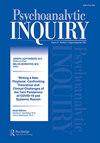居住的房间:一位建筑师的回忆
IF 0.5
4区 心理学
Q3 PSYCHOLOGY, PSYCHOANALYSIS
引用次数: 0
摘要
家是我们不成文的自传,是我们最依恋的地方。因此,我们的房子应该和我们一样独特,满足我们最深的欲望,丰富我们在特定时间和地点的生活。这篇文章的目的是确定是什么因素,无论是身体上的还是情感上的,使我们有可能为自己设计这样独特的房子。对于建筑师设计的住宅,为了实现这一目标,必须发现并向建筑师透露哪些信息?作者讨论了他40多年来设计房子的过程,他们的主人喜欢和珍惜,从让客户记住和分析他们最喜欢的童年地方开始。他认为,“只有详细、亲密、独特的描述才能让你拥有一所独特的房子”,而“让你感到舒适的最有价值的指南”——比照片、杂志剪报或成千上万的住房网站链接都要多——是对那个特别的童年地方的记忆。他总结道,决定是什么让这个地方如此特别,是我们通往一个和我们一样独特的新家的旅程的开始。关键词:家居心理学设计独特的家建筑师设计的房子设计自己的家披露声明作者未报告潜在的利益冲突。frank Harmon,美国联邦建筑师协会,在东南部设计可持续的现代建筑已有40年的历史。当他还是个孩子的时候,他在家乡北卡罗来纳州格林斯博罗的小溪和树林里玩耍,发现了建筑。他的作品涉及紧迫的当代问题,如无地性、可持续性以及城市和自然的恢复。他设计的建筑是特定于他们的地点,并使用诸如飓风砍伐的柏树和当地采石场的岩石等材料将它们与他们的景观联系起来。通风的走廊、户外生活空间、深悬、宽阔的草坪体现了南方的乡土遗产,同时保持了杰出的现代主义。Frank毕业于伦敦建筑协会,是北卡罗来纳州立大学设计学院的教授。他曾任教于建筑协会,并在哈佛大学、弗吉尼亚大学和奥本大学的乡村工作室担任访问评论家。他的作品经常被发表,并获得了200多个设计奖项。他最近获得了AIANC建筑设计金奖。ORO Editions于2018年10月出版了他的新书《本土:绘画作为一种观看方式》。本文章由计算机程序翻译,如有差异,请以英文原文为准。
Rooms to Live In: An Architect’s Recollections
ABSTRACTOur homes are our unwritten autobiographies, the places to which we are most emotionally attached. As such, our houses should be as unique as we are, satisfying our deepest desires and enriching our lives in our specific time and place. The purpose of this essay was to determine what factors, both physical and emotional, make it possible to design such unique houses for ourselves. For an architect-designed home, what information must be discovered and revealed to the architect to achieve this goal? The author discusses the process he employed over 40 years of designing houses that their owners loved and cherished, beginning with having clients remember and analyze their favorite childhood places. He suggests that “only a detailed, intimate, and uniquely specific description will tender a unique house,” and that “the most valuable guide to what makes you comfortable” – more than photos, magazine clippings, or thousands of links to shelter websites – is the memory of that special childhood place. Determining what made that place so special, he concludes, is the beginning of our journey toward a new home that is as unique as we are.KEYWORDS: Psychology of homecustom homesdesigning unique homesarchitect-designed housesdesigning your own home Disclosure statementNo potential conflict of interest was reported by the author.Additional informationNotes on contributorsFrank HarmonFrank Harmon, FAIA, has designed sustainable modern buildings across the Southeast for 40 years. He discovered architecture as a child playing in the streams and woods of his native Greensboro, North Carolina. His work engages pressing contemporary issues such as placelessness, sustainability, and restoration of cities and nature.The buildings he designs are specific to their sites and use materials such as hurricane-felled cypress and rock from local quarries to connect them to their landscapes. Airy breezeways, outdoor living spaces, deep overhangs, and wide lawns embody the vernacular legacy of the South while maintaining a distinguished modernism.Frank is a graduate of the Architectural Association in London and a professor at the North Carolina State University College of Design. He has taught at the Architectural Association and has served as a visiting critic at Harvard, the University of Virginia, and Auburn University’s Rural Studio.His buildings are frequently published and have garnered over 200 design awards. He recently received the AIANC Gold Medal for Architectural Design. ORO Editions published his new book Native Places: Drawing as a Way to See in October 2018.
求助全文
通过发布文献求助,成功后即可免费获取论文全文。
去求助
来源期刊

Psychoanalytic Inquiry
PSYCHOLOGY, PSYCHOANALYSIS-
CiteScore
1.00
自引率
33.30%
发文量
65
期刊介绍:
Now published five times a year, Psychoanalytic Inquiry (PI) retains distinction in the world of clinical publishing as a genuinely monographic journal. By dedicating each issue to a single topic, PI achieves a depth of coverage unique to the journal format; by virtue of the topical focus of each issue, it functions as a monograph series covering the most timely issues - theoretical, clinical, developmental , and institutional - before the field. Recent issues, focusing on Unconscious Communication, OCD, Movement and and Body Experience in Exploratory Therapy, Objct Relations, and Motivation, have found an appreciative readership among analysts, psychiatrists, clinical psychologists and a broad range of scholars in the humanities.
 求助内容:
求助内容: 应助结果提醒方式:
应助结果提醒方式:


